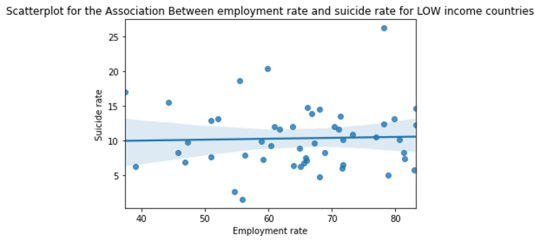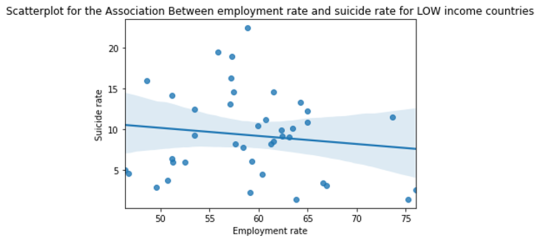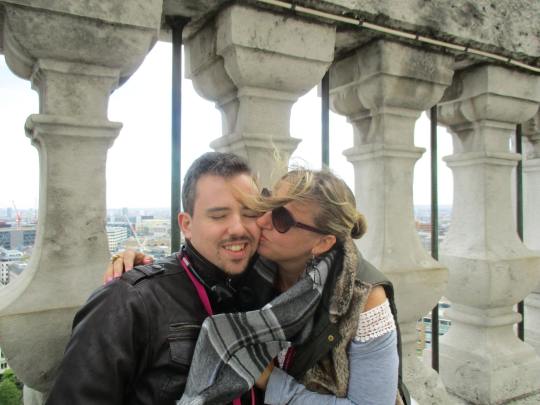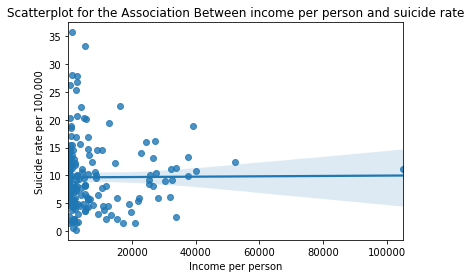#suiciderates
Explore tagged Tumblr posts
Link
#Adolescents#Alcohol#Anxiety#CelebratingYourGiftofLife#Childhood#Depression#JamesDonaldson#JamesDonaldsonnotes:Welcometothe“nextchapter”ofmylife…beingavoiceandanadvocateformentalhealthawarenessandsuicideprevention#JamesDonaldsonMentalHealth#JamesDonaldsononMentalHealth#Men#MentalChallenges#MentalHealth#MentalHealthConditions#MentalHealthCrisis#MentalHealthDisorders#MentalHealthIssues#MentalHealthServices#MentalHealthStigma#MentalIllness#MentalIssues#Stigma#SubstanceAbuseDisorders#SubstanceUse#SubstanceUseDisorder#Suicide#SuicideRates#Trauma#WHO#woman
0 notes
Text
"What If ISIS Killed a Man Every Minute? The Shocking Truth About Suicide Rates"
#ISIS#SuicideRates#MentalHealthAwareness#GlobalCrisis#SocialImpact#WorldAffairs#HypotheticalScenarios#ThoughtProvokingContent#MentalHealthMatters#CrisisResponse#RealWorldIssues#GlobalImpact#ComparativeAnalysis#SuicidePrevention
0 notes
Text
Assignment Week 2: Running Your First Program
TITLE
Impact of Employment on Mental Health Globally from Gapminder Data: Analyzing the Relationship between employment rates and suicide rates across countries?
Refined Research Question:
How do employment rates impact suicide rates globally, and does this association change when considering income per person, urbanization, and alcohol consumption?
NOTE: The Data presented and analyzed based on the Data presented by Gapminder Dataset provided in the course material.
Explotary Data Analysis. *We will explore the Gapminder datasets and try to gain insihts about the data using basic statistics metrics using python










Conclusion:
We saw there are 213 observations and 16 columns(features) provided in the gapminder dataset as per the course material There is one categorical column "country" and the rest are numeric variables based on my reserach question: Impact of Employment on Mental Health Globally from Gapminder Data: Analyzing the Relationship between employment rates and suicide rates across countries? Refined Research Question: How do employment rates impact suicide rates globally, and does this association change when considering income per person, urbanization, and alcohol consumption?
below are the list of variables that I will be considering for my research project: employrate suicideper100th incomeperperson urbanrate alcconsumption female employrate (additional)
Data Processing/Cleaning:
On doing basic analysis and EDA we found that there were around 50 records which had one or the other missing data which consitituted to around 23% missing data. To handle missing data, we first added a region column to map the countries to respective regions Then using the region we used the group mean to replace the the missing data.
Frequency/Distribution:
Looking at the frequency distribution of the three variables of interest: 1. incomeperperson: It is seen that majority of the countries mean incomeperperon is is up to 10000 USD with few falling between 10K to 40K and wee also see their are outliers above 40K. Data is right skewed. 2. Suiciderate is showing with majority of the countries falling with a mean of 9.57 and std of 6.07 and we see there are some outliers 3. employrate shows that in majority of the countries around 58.72 % of population age above 15+ are employed with std of 9.8. 4.
We will have to do more data processing to see how best we can use the data to gain further insights and relationships between the variables.
0 notes
Text
When I won’t meet you half way in your bigotry because #suiciderates
0 notes
Text
Data Analysis tools Assignment 4: Moderator
Data Analysis tools Assignment 4: Moderator
Study topic:
Employment rate Vs Suicide rate
Variables of interest:
Flow sequence for a python program
Steps:
Read the csv file.
Convert the datas of interest to numeric
Select only the readable data (exclude null or NaN)
Run Pearson correlation test on overall data.
Convert the moderator “income per person” into categorical variable into 3 categories and name the new variable as “incomegrp” a. 1 – LOW INCOME countries b. 2 – MIDDLE INCOME countries c. 3 – HIGH INCOME countries
Run Pearson correlation test for each level of moderator.
Python program
#Importing libraries
import numpy as np
import pandas
import statsmodels.formula.api as smf
import statsmodels.stats.multicomp as multi
import scipy.stats
import seaborn
import matplotlib.pyplot as plt
#Reading the data csv file
data = pandas.read_csv('gapminder.csv')
### Suiciderate is response variable whereas employment rate is explanatory variable
#setting variables of interest to numeric and creating datasets for response and explanatory variables
data['suicideper100th'] = pandas.to_numeric(data['suicideper100th'],errors = 'coerce')
data['incomeperperson'] = pandas.to_numeric(data['incomeperperson'],errors = 'coerce')
data['employrate'] = pandas.to_numeric(data['employrate'],errors = 'coerce')
#Subset for data of interest
di = data[['suicideper100th', 'incomeperperson','employrate']].dropna()
di
#Calculating Pearson correlation coefficient on overall data
print (scipy.stats.pearsonr(di['employrate'], di['suicideper100th']))
Output:
(0.01753468728377806, 0.8241876850138514)
#Categorizing income per person to 3 different levels to make incomeperperson as a categorical explanatory variable as well
def incomegrp (row):
if row['incomeperperson'] <= 800:
return 1
elif row['incomeperperson'] <= 9000 :
return 2
elif row['incomeperperson'] > 9000:
return 3
di['incomegrp'] = di.apply (lambda row: incomegrp (row),axis=1)
#Subgrouping data according to income group levels
sub1=di[(di['incomegrp']== 1)]
sub2=di[(di['incomegrp']== 2)]
sub3=di[(di['incomegrp']== 3)]
#Running Pearson correlation coefficient test on each sub group
print ('Association between employment rate and suicide rate for LOW income countries')
print (scipy.stats.pearsonr(sub1['employrate'], sub1['suicideper100th']))
Output:
Association between employment rate and suicide rate for LOW income countries
(0.03469540098012962, 0.8109502633870055)
print ('Association between employment rate and suicide rate for MEDIUM income countries')
print (scipy.stats.pearsonr(sub2['employrate'], sub2['suicideper100th']))
Output:
Association between employment rate and suicide rate for MEDIUM income countries
(0.053355137933444076, 0.6539237810305579)
print ('Association between employment rate and suicide rate for HIGH income countries')
print (scipy.stats.pearsonr(sub1['employrate'], sub1['suicideper100th']))
Output:
Association between employment rate and suicide rate for HIGH income countries
(0.03469540098012962, 0.8109502633870055)
#Scatterplots
scat1 = seaborn.regplot(x="employrate", y="suicideper100th", data=sub1)
plt.xlabel('Employment rate')
plt.ylabel('Suicide rate')
plt.title('Scatterplot for the Association Between employment rate and suicide rate for LOW income countries')
print (scat1)

scat2 = seaborn.regplot(x="employrate", y="suicideper100th", data=sub2)
plt.xlabel('Employment rate')
plt.ylabel('Suicide rate')
plt.title('Scatterplot for the Association Between employment rate and suicide rate for LOW income countries')
print (scat2)

scat3 = seaborn.regplot(x="employrate", y="suicideper100th", data=sub3)
plt.xlabel('Employment rate')
plt.ylabel('Suicide rate')
plt.title('Scatterplot for the Association Between employment rate and suicide rate for LOW income countries')
print (scat3)

Discussion from Moderator tests:
When examining the association between employment rate with suicide rate, Pearson correlation test showed that suicide rate does not depend on employment rate (r = 0.01175 (very low) and p=0.824 > 0.05 significance level).
It was hypothesized that the income level of a country could be a moderator in this study. Hence, with countries sub-grouped into 3 different levels: low-income, middle-income, and high-income groups, Pearson correlation test to test an association of employment rate and suicide rate was conducted again on each group. Groupwise test again showed that for each group, the association was statistically insignificant:
Low-income countries - r = 0.0346 (very low) and p=0.65 > 0.05 significance level)
Middle-income countries - r = 0.0533 (very low) and p=0.65 > 0.05 significance level)
High-income countries - r = -0.133 (very low) and p=0.41 > 0.05 significance level)
One thing to notice from the results and the scatter plot was: As the employment rate increased, suicide rate increased as well for low and middle-income countries whereas it decreased for high-income countries (even though the slope was extremely small).
0 notes
Video
One of my biggest mental health battles is struggling with suicidal thoughts. I have attempted suicide in the past and God was merciful and blessed me with my brother in my time of need. But even now days I struggle with this utter despair and hopelessness. My mom got me this bracelet a few days ago. It’s a simple bracelet with yellow strands and part of the profit of these bracelets goes to suicide prevention and awareness. This is important to me because of my own trials. I’m blessed I have an amazing support system and I have friends all over the world who love me and pray for me. I have this beautiful blog and I’m so excited to grow GraceLife and partner with shalom ministries really soon. But not everyone out there has that support that hope. I challenge you today to find someone and make them smile. It can be by sending a gif through text or by mailing a card to them. It can be with a hug or a silly Snapchat. You never know how you will impact their life. #challengethestigma #makesomeonesmile #mentalhealthawareness #suicideprevention #suicideawarness #suicidepreventionawareness #suicidepreventionandawareness #mentalhealth #mentalhealthmatters #christianmentalhealthblogger #christianmentalhealth #christianmentalhealthwarrior #mentalhealthadvocate #newday #saynotosuicide #nosuicide #projectsemicolon #suiciderates #endthestigmaofmentalhealth #mentalhealthishealth #mental #health #bold #puravidabracelets #endsuicide #affordablementalhealthcare #christianmentalhealthawareness #christianmentalhealth #bekind #endthestigmaaroundsuicide #suicideisnottheanswer https://www.instagram.com/p/CC6dD5TDxqK/?igshid=dpgrc21s89zb
#challengethestigma#makesomeonesmile#mentalhealthawareness#suicideprevention#suicideawarness#suicidepreventionawareness#suicidepreventionandawareness#mentalhealth#mentalhealthmatters#christianmentalhealthblogger#christianmentalhealth#christianmentalhealthwarrior#mentalhealthadvocate#newday#saynotosuicide#nosuicide#projectsemicolon#suiciderates#endthestigmaofmentalhealth#mentalhealthishealth#mental#health#bold#puravidabracelets#endsuicide#affordablementalhealthcare#christianmentalhealthawareness#bekind#endthestigmaaroundsuicide#suicideisnottheanswer
5 notes
·
View notes
Photo

#suiciderates (at Toll Gate Creek Trail) https://www.instagram.com/p/CXyjdTyO2wn/?utm_medium=tumblr
0 notes
Link
#Anxiety#CelebratingYourGiftofLife#Depression#JamesDonaldson#JamesDonaldsonnotes:Welcometothe“nextchapter”ofmylife…beingavoiceandanadvocateformentalhealthawarenessandsuicideprevention#JamesDonaldsonMentalHealth#JamesDonaldsononMentalHealth#Men#MentalChallenges#MentalHealth#MentalHealthCrisis#MentalHealthProfessionals#MentalHealthStigma#MentalIllness#MentalIssues#Military#MilitaryCrisisLine#Parents#Suicide#SuicidePrevention#SuicideRates#VeteranCrisisLine#Veterans#VeteransAdministration#VeteransAffairs#VeteransCrisisLine#VeteransHealthAdministration#woman#YourGiftofLife#YourGiftofLife.org
0 notes
Text
Suicide Contagion

Suicide contagion is when one person is so emotional from the loss of another person’s suicide, that they also commit suicide.The effect can be from suddenly losing someone very close like a best friend or family member, to losing a beloved popular figure, like Robin Williams. In either case, the likely-hood of a person taking their own life due to a loved one’s suicide, increases by 67%. Not a small increase.
Another large statistic finds that an estimated 48 and 500 million people every year, deeply grieve for a person that kills themself. This number, while it clearly has a huge margin, isn’t totally shocking considering about 1 million people are successful at killing themselves every year (not including the attempts that aren’t successful).
So essentially, every year 1 million people take their own life and 48-500 million people are 67% more likely to take their own life due to grief.
*Statistics attained from: http://www.thelancet.com/journals/lanpsy/article/PIIS2215-0366(14)70224-X/fulltext
I completely understand why suicide risk is increased after losing someone special to a suicide, this is why:
Personally, I think this is so because of plain old grief. My pain is so deep, I want to cut myself to feel physical pain to distract my heart. There is a ache that I feel in my mind, my heart, my bones and all my cells, and I don’t see an end to that pain, in sight. Death sounds like a sweet refuge from this life that has no light.
For me, Diogo’s absence is enough to make me want to leave this world. where I once saw miles of vast lands cleared for possibilities; I now see a vacant wasteland of nothingness. I see nothing but a hole that will never be filled. Diogo wrote in his note that he lost his “why,” and now he’s gone and I’ve lost my “why” too.
When you lose someone significant, it’s like losing a fallen hero. It’s common to think that if they can’t make it in life (and they are way more amazing than I could ever be), then I can’t make it and I should give up now. Diogo studied science, society, religion and peace. He knew everything to me, and clearly he must have known something that I don’t, which is why he took his life; and maybe ending my life now is the best option.
Not to mention the guilt. I feel like I am partly responsible for his death. I should have, could have, did, didn’t do something that I thought about doing. I could have made a difference and shown him a window where he saw only stark walls. Diogo always said this world is illusions and I could have shown him a different illusion that could have made him decide to stay with us. I feel guilt beyond measure and ending the guilt sounds like a sweet dream.
All of these feelings make me 67% more likely to take my life, statistically speaking. But if you look at just me, and don’t throw me in with all the other people in the world, I’m sure my possibility is much higher. How would I do it? I don’t know, I give it no thought; I don’t want to do anything that is out of the natural order. I just lay in bed at night and wish I would naturally bleed out. Why, you may ask? Because I have so much pain that I wish I could drain my body of ever ounce of grief, guilt, pain, confusion, frustration and self-pity.
I think about this in secret. I don’t talk about it, I deny it, I bury it in a corner and like a split personality I talk about suicide like it’s so far from me, not accessing the place I can relate to it. In this way, I am exactly like him. He did this every day, with most people. He carried this buried idea almost living a double life for 12 years. Living happily, living life to the fullest, discussing politics, posterity, naming our babies, and yet all along he knew it would end his way. He was pretending, and now I am pretending too.
#bleedingout#pain#heartache#heartbreak#coupling#surviving#coping#suiciderates#suicidecontagion#suicideblog#suicideawareness#suicide#please come back#takemewithyou#iloveyou#dontleaveme#istillmisshim#interrealmal#takinginair#lovestory#sadstory
3 notes
·
View notes
Video
youtube
What If ISIS Killed a Man Every Minute? The Shocking Truth About Suicide...
#youtube#ISIS SuicideRates MentalHealthAwareness GlobalCrisis SocialImpact WorldAffairs HypotheticalScenarios ThoughtProvokingContent MentalHealthMat
1 note
·
View note
Photo

#Repost @parentstogether (with @report.for.insta) ... Suicide attempts have declined among teens overall, with the major exception of black teens, found a study based on nationwide data from 200,000 high school students collected between 1991 and 2017. The study, published in Pediatrics, showed that self-reported suicide attempts increased proportionally in black teens, even though they decreased or followed no significant trend in white, Hispanic, Asian/Pacific Islander, and American Indian/Alaska Native teens.⠀ Follow the link in bio [ @parentstogether ] for the full story. ...⠀ #suicide #suiciderates #teensuicide #suicidehelp #parentstogether #parentnews #parenting #parentinfo #blackteensuicide https://www.instagram.com/p/B4HBfPVF9HU/?igshid=1ls0k8b6jvrr3
#repost#suicide#suiciderates#teensuicide#suicidehelp#parentstogether#parentnews#parenting#parentinfo#blackteensuicide
0 notes
Text
So Suicide Is A Thing

Did you know that suicide rates are rising in America? Of course you do, because everyone knows. America, home of the free and land of the dead. Right? In 2016, about 45,000 Americans from age ten (10) and older died by suicide. That means ten year old and twelve year old kids thought that it’d be better to end it then and there. That means elementary school students thought the end was better than the then. Suicide is the 10th leading cause of death, and one of three that is on the rise. (x)
From the year 1999 to the year 2016 these states had a suicide rate increase of 38-58%: Montana, North Dakota, South Dakota, Minnesota, Idaho, Wyoming, Utah, Kansas, Oklahoma, South Carolina, Vermont, and New Hampshire. Iowa, Michigan, Missouri, Arkansas, Indiana, Ohio, Kentucky, West Virginia, Pennsylvania, Massachusetts. and Alaska all had a 31-37% increase in those same years. Nevada was the only state that had a decrease, and it was only 1% in seventeen years. (x)
In 2017, there were 47,173 recorded suicides in America. That same year, there were an estimated 1,400,000 recorded suicide attempts. In 2015, suicide and self harm cost the United States $69 BILLION. In 2017, the suicide rate (age-adjusted) was 14 for every 100,00 individuals. The recorded suicide rate is highest in middle aged white men. In 2017, men died by suicide 3.54x more than women. On AVERAGE there are ONE HUNDRED AND TWENTY NINE SUICIDES A DAY. White males accounted for 77.97% of suicide deaths in 2017. Firearms accounted for about half of all suicide deaths that same year. (x)
In 2017, the highest suicide rate (20.2) was among adults between 45 and 54 years old. The second highest (20.1) was 85 and older. In 2017, adolescents and young adults aged 15 to 24 had a rate of 14.46. (x)
Firearms make up 50.6% of suicide death methods. Followed by suffocation (27.7%) and then poisoning (13.9%). All other methods are in the 7.8%. In 2015, about 575,000 people were admitted into a hospital for self harm injuries. In 2017, based on the National Survey of Drug Use and Mental Health, around .6% of adults 18+ made at least one suicide attempt. This translates to approximately 1.4 million adults. (x)
Posted on November 29, 2018, an online reporter named Julissa Treviño posted an article about suicide rates rising. “According to a new report by the Centers for Disease Control and Prevention, 47 thousand Americans died by suicide in 2017. Put another way, the suicide rate was 14 in every 100 thousand -- up 33% from 10.5 people pre 100 thousand in 1999.” She reports that the suicide rate is at a 50-year peak. With more than 2,000 more deaths from suicide last year than in 2016, this is the year that suicide became the second leading cause of death for Americans aged 10-34 and the fourth leading cause of death for middle-aged Americans. (x)
Suicide is a problem, that many don’t seem to notice. Yeah, some don’t show any warning signs, but maybe try talking to them? Making sure they’re okay? So many souls have been broken by the ones lost to suicide. It’s a big issue, mostly cause by public schooling, society’s issues, stress, and the economy. These things need to be fixed, but no one is doing anything.
Sounds like many of the other issues the world has right now. Right?
#suicide#statistics#suicidestatistics#article#death#selfharm#percentages#2017#2015#2016#2018#2019#suiciderates#suicideattempts#firearms
0 notes
Text
Adolescent Health-2
This is my second project on the National Longitudinal Study of Adolescent Health (AddHealth).I chose to study on the correlation between the emotional feeling scale and the suicide attempts.
The variables i considered are:
1)H1FS9-people who thought their life had been a failure
2)H1FS3- who thought they couldn’t shake off their blues even with the help of family and friends
3)H1SU1- who that thought of committing suicide in past 12 months.
I have observed that though more than 80% of the people feel depressed due to above characteristics considered less than 15% of population had suicide thoughts.Also I wanted to observe if US citizenship(US culture and life) affects their emotional scale but it doesn’t .There are no missing values in the data.



3 notes
·
View notes
Text
Data Analysis tools Assignment 3: Correlation coefficient
Reminder (research problem and defined variables)
Study topic:
Primary topic
Suicide rate Vs. incomeperperson
Variables of interest:
suicideper100th: This data gives the number of suicide due to self-inflicted injury per 100,000 people in any particular country. This rate is calculated as if all countries had the same age composition of the population. The data is based on the “Global burden of disease study” from WHO.
incomeperperson: The data contains GDP per capita in US dollars divided by midyear population. This data is calculated adjusting the global inflation (without making deductions for the depreciation of fabricated assets or for depletion and degradation of natural resources). The data was provided by world bank.
Flow sequence for a python program
Steps:
Read the csv file
Convert data of interest to numeric
Select only readable data (exclude null or NaN)
Generate scatter plot of response variable (suicideper100th) vs. explanatory variable (incomeperperson)
Generate the Pearson-correlation coefficient.
Python program
#Importing libraries
import numpy
import pandas
import statsmodels.formula.api as smf
import statsmodels.stats.multicomp as multi
import scipy.stats
import seaborn
import matplotlib.pyplot as plt
#Reading the data csv file
data = pandas.read_csv('gapminder.csv')
### Suiciderate is response variable whereas incomeperperson is explanatory variable
#setting variables of interest to numeric and creating datasets for response and explanatory variables
data['suicideper100th'] = pandas.to_numeric(data['suicideper100th'],errors = 'coerce')
data['incomeperperson'] = pandas.to_numeric(data['incomeperperson'],errors = 'coerce')
#Subset for data of interest
dataofinterest = data[['suicideper100th', 'incomeperperson']].dropna()
dataofinterest
#Scatter plot
scat1 = seaborn.regplot(x="incomeperperson", y="suicideper100th", fit_reg=True, data=dataofinterest)
plt.xlabel('Income per person')
plt.ylabel('Suicide rate per 100,000')
plt.title('Scatterplot for the Association Between income per person and suicide rate')

#Pearson correlation coefficient
data_clean=dataofinterest.dropna()
print ('Association Between income per person and suicide rate')
print (scipy.stats.pearsonr(data_clean['incomeperperson'], data_clean['suicideper100th']))
Output:
Association Between income per person and suicide rate
(0.0065552893496113665, 0.9302086466053822)
Discussion from Correlation coefficient test:
When examining the association between income per person with suicide rate, correlation coefficient (r) was found to 0.00655, which is positive – so it shows a higher suicide rate with higher income); but the value is extremely small (nearly zero). This means the correlation between income per person to suicide rate is basically none. Also, the p-value is (p=0.93 > 0.05), which also indicates statistically insignificant relationship.
This can be seen from scatter plot as well. The graph looks like a straight horizontal line [nearly a y=0 line]. This again points to extremely low (close to none) association between income per person and suicide rate.
0 notes
Video
instagram
"Bullied" Part #1 #bullied #bully #stories #suicide #suiciderate #suicidal #death #dead #chatstory #chats #mystery #thriller #mysterious #friendship #peerpressure #peer #pressure #losingafriend #lostfriendship #girls #agirl #instagramstories #instastories #creativity #writersofinstagram #writingcommunity #ttt #ttccommunity #terribletinytales #tttstories #tinytales #part1 #partone #shocking #video #cover #munziewriteups https://www.instagram.com/p/BxDf0QhH46x/?utm_source=ig_tumblr_share&igshid=1m2v94dnz9grq
#1#bullied#bully#stories#suicide#suiciderate#suicidal#death#dead#chatstory#chats#mystery#thriller#mysterious#friendship#peerpressure#peer#pressure#losingafriend#lostfriendship#girls#agirl#instagramstories#instastories#creativity#writersofinstagram#writingcommunity#ttt#ttccommunity#terribletinytales
2 notes
·
View notes